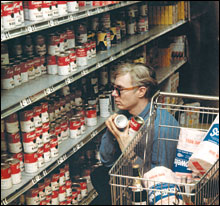 He was Andrew Warhola on his birth certificate, son of Andrej and Julia, Ruthenian immigrants from Czechoslovakia who spoke Slovak at home and worshiped every Sunday at the Eastern Rite Byzantine Catholic Church in a gritty Western Pennsylvania mill and mining community of the sort portrayed in the opening scenes of The Deer Hunter.
He was Andrew Warhola on his birth certificate, son of Andrej and Julia, Ruthenian immigrants from Czechoslovakia who spoke Slovak at home and worshiped every Sunday at the Eastern Rite Byzantine Catholic Church in a gritty Western Pennsylvania mill and mining community of the sort portrayed in the opening scenes of The Deer Hunter. Throughout the 1950s, he was “Raggedy Andy” to the art directors of magazines (Vogue, Mademoiselle, Harper’s Bazaar) and posh stores (Tiffany, Bergdorf Goodman) and shoe lines (I. Miller) who commissioned his work — often blotted ink-line drawings that, when mechanically mass-produced on newsprint or on slick paper, suggested an intimate spontaneity — and, in the process, made Warhol (he had dropped the “a” by this time) affluent and (perhaps) New York’s most successful commercial artist.
During the 1960s, when Warhol turned to fine art and established the first of his three “factories” in an industrial loft in the then-fallow southern precincts of midtown, he was known as “Drella” to the assortment of street people, speed freaks, transvestites, poets, fellow artists, underground filmmakers, gallery owners, collectors, curators, socialites, and celebrities who worked in, hung around at, and passed through his studio. By then, aspects of Warhol’s chameleon-like persona had emerged sufficiently to be recognized and catalogued by his associates. He was, in turns, perversely pixie-like, passively aggressive, casually workaholic, blandly intense, promiscuously manipulative, and monumentally ambitious.
By the 1970s, he was Andy or Ahn-dy or Ahn-deeee, pronunciation depending on the speaker’s nation of origin or pretense to intimacy. Andy was an international celebrity, as famous for being himself at parties, in gossip pages, in commercials, and as the subject of magazine articles as he was for his large and still growing body of work: paintings, ready-mades, silk-screened portraits, films, books, and his magazine, Interview.
Like America’s first true pop-cultural heroes, Theodore Roosevelt and Charles Lindberg, and like the first international darling of the art world, Pablo Picasso, Warhol was more than iconic; he was and remains a brand — a medium through which one could transform one’s everyday self (if just a little) into someone more enhanced — perhaps, if the imagination was strong enough, into a superstar. The kind of superstar who gets a 15-pound book about him — Andy Warhol “Giant” Size (Phaidon) — published 19 years after his death.
Superstardom, on the surface at least, is a powerful aspect of Warhol’s art. He chose Elvis Presley and Marilyn Monroe and Jackie Kennedy as subjects at a time when those cultural touchstones were merely famous, though in transition for sure — on their ways, each in his or her own particular fashion, to becoming icons, but not yet iconic. The bold, flatly luminous technique with which Warhol represented them captured their essence and aura. By focusing and refining their immediacy, Warhol gave them timeless relevance. His transcendent achievement — measured by his multiple Elvises, Marilyns, and Jackies — owed as much to selection as execution, to thought as action, to intuition as system.